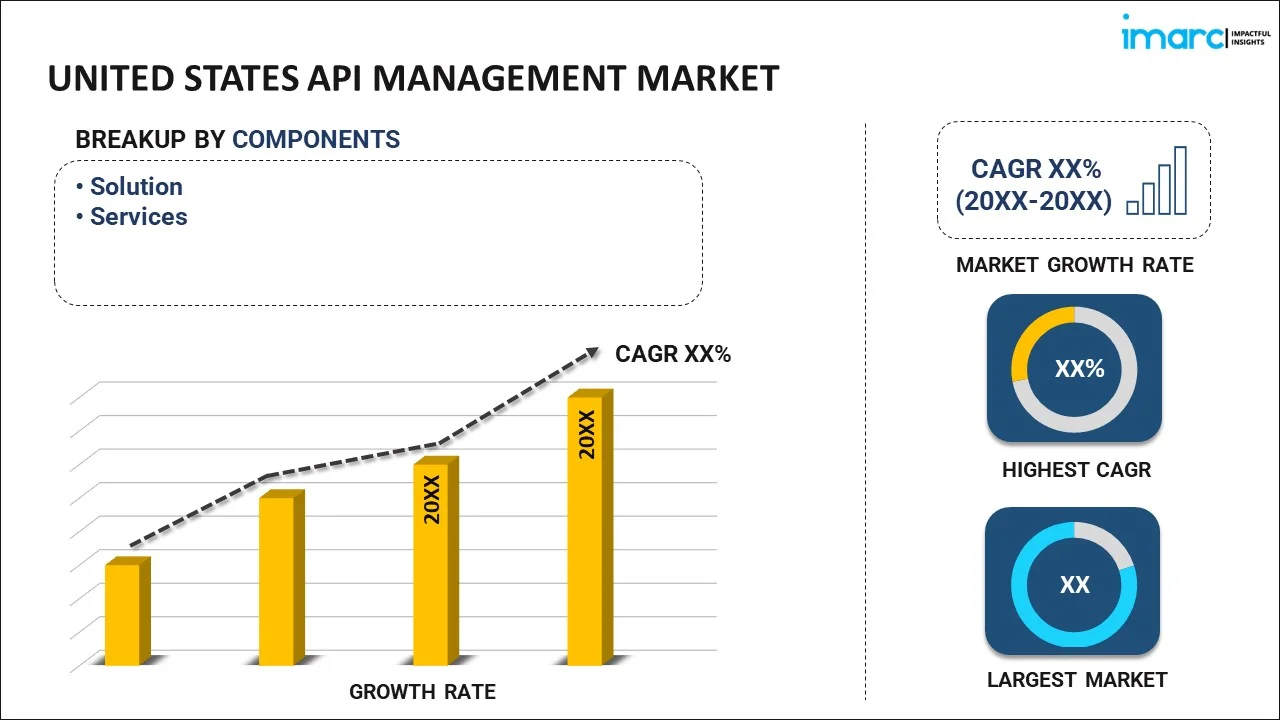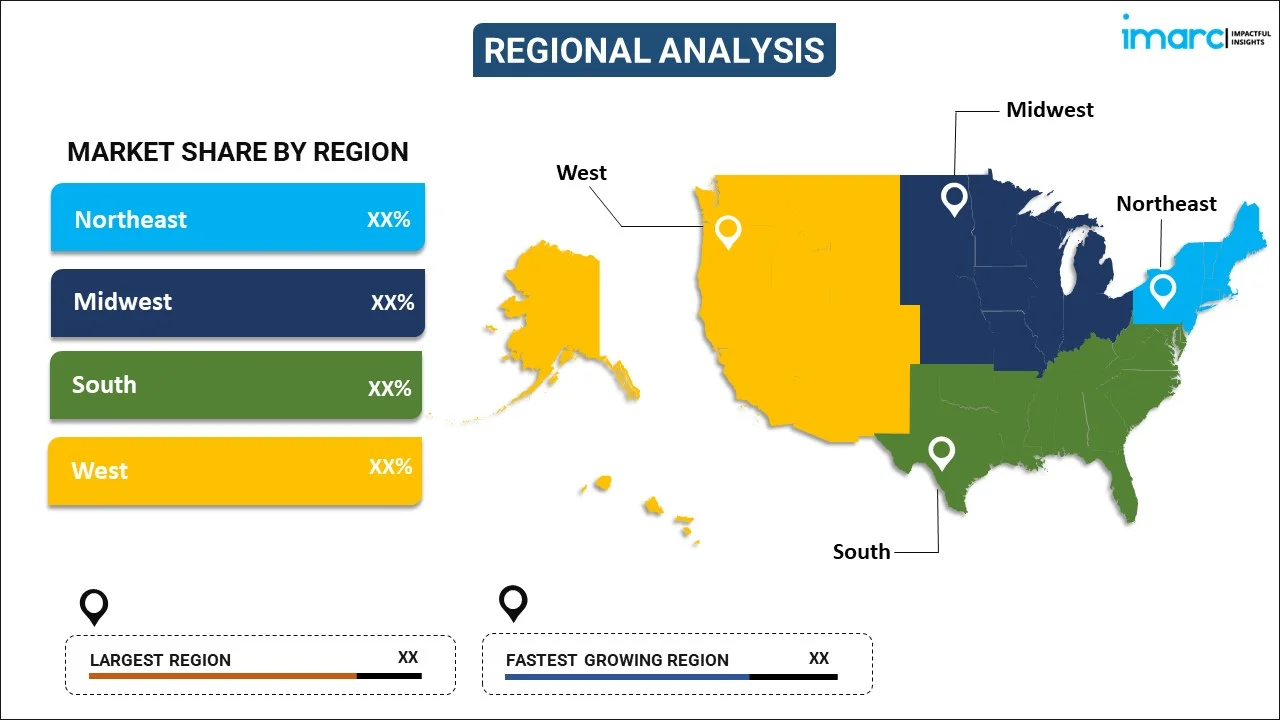
United States API Management Market Report by Component (Solution, Services), Deployment Type (Cloud-based, On-premises), Organization Size (Large Enterprises, Small and Medium-sized Enterprises), Industry Vertical (BFSI, IT and Telecom, Retail and Consumer Goods, Travel and Transportation, Government, Media and Entertainment, Healthcare and Life Sciences, Manufacturing, and Others), and Region 2024-2032
Market Overview:
United States API management market size is projected to exhibit a growth rate (CAGR) of 25.00% during 2024-2032. The increasing adoption of microservices architecture, where applications are built as a collection of small, independent services to ensure seamless communication between them, is driving the market.
|
Report Attribute
|
Key Statistics
|
|---|---|
|
Base Year
|
2023 |
|
Forecast Years
|
2024-2032
|
|
Historical Years
|
2018-2023
|
| Market Growth Rate (2024-2032) | 25.00% |
API (application programming interface) management involves the design, deployment, and maintenance of APIs to ensure seamless communication and interaction between different software applications. It encompasses a set of tools and processes that facilitate the creation, documentation, testing, and monitoring of APIs. API management platforms offer features such as access control, security, versioning, analytics, and developer collaboration, allowing organizations to control and optimize the lifecycle of their APIs. These platforms enable businesses to streamline API development, enhance security measures, monitor API performance, and manage the overall API ecosystem efficiently. In essence, API management is crucial for organizations looking to maintain agility, scalability, and security while enabling interoperability between diverse software systems and fostering a robust and efficient digital ecosystem.
United States API Management Market Trends:
The API management market in the United States is driven by several factors that collectively shape its trajectory. Firstly, the relentless pace of digital transformation across industries propels the API management market forward. As organizations increasingly adopt cloud-based solutions and diversify their IT landscapes, the demand for effective API management solutions grows. Furthermore, the escalating need for seamless integration between diverse applications fuels the market's expansion. This imperative arises as businesses seek to enhance operational efficiency, streamline processes, and deliver more cohesive user experiences. Moreover, the rising significance of data security acts as a pivotal driver in the API management market. As cyber threats become more sophisticated, organizations prioritize robust API security measures to safeguard sensitive information. Additionally, the proliferation of mobile devices and the Internet of Things (IoT) amplifies the demand for agile API management solutions capable of handling diverse data sources and communication channels. Furthermore, the regional nature of business operations and the increasing complexity of ecosystems, which underscore the importance of scalable and interoperable API management platforms, is expected to drive the market in the United States during the forecast period.
United States API Management Market Segmentation:
IMARC Group provides an analysis of the key trends in each segment of the market, along with forecasts at the country level for 2024-2032. Our report has categorized the market based on component, deployment type, organization size, and industry vertical.
Component Insights:

- Solution
- API Platform
- API Analytics
- API Security
- Services
- Integration and Implementation
- Consulting
- Support and Maintenance
- Training and Education
The report has provided a detailed breakup and analysis of the market based on the component. This includes solution (API platform, API analytics , and API security) and services (integration and implementation, consulting, support and maintenance, and training and education).
Deployment Type Insights:
- Cloud-based
- On-premises
A detailed breakup and analysis of the market based on deployment type have also been provided in the report. This includes cloud-based and on-premises.
Organization Size Insights:
- Large Enterprises
- Small and Medium-sized Enterprises
The report has provided a detailed breakup and analysis of the market based on the organization size. This includes large enterprises and small and medium-sized enterprises.
Industry Vertical Insights:
- BFSI
- IT and Telecom
- Retail and Consumer Goods
- Travel and Transportation
- Government
- Media and Entertainment
- Healthcare and Life Sciences
- Manufacturing
- Others
A detailed breakup and analysis of the market based on industry vertical have also been provided in the report. This includes BFSI, IT and telecom, retail and consumer goods, travel and transportation, government, media and entertainment, healthcare and life sciences, manufacturing, and others.
Regional Insights:

- Northeast
- Midwest
- South
- West
The report has also provided a comprehensive analysis of all the major regional markets, which include the Northeast, Midwest, South, and West.
Competitive Landscape:
The market research report has also provided a comprehensive analysis of the competitive landscape in the market. Competitive analysis such as market structure, key player positioning, top winning strategies, competitive dashboard, and company evaluation quadrant has been covered in the report. Also, detailed profiles of all major companies have been provided.
United States API Management Market Report Coverage:
| Report Features | Details |
|---|---|
| Base Year of the Analysis | 2023 |
| Historical Period | 2018-2023 |
| Forecast Period | 2024-2032 |
| Units | US$ Million |
| Scope of the Report | Exploration of Historical and Forecast Trends, Industry Catalysts and Challenges, Segment-Wise Historical and Predictive Market Assessment:
|
| Components Covered |
|
| Deployment Types Covered | Cloud-based, On-premises |
| Organization Sizes Covered | Large Enterprises, Small and Medium-sized Enterprises |
| Industry Verticals Covered | BFSI, IT and Telecom, Retail and Consumer Goods, Travel and Transportation, Government, Media and Entertainment, Healthcare and Life Sciences, Manufacturing, Others |
| Regions Covered | Northeast, Midwest, South, West |
| Customization Scope | 10% Free Customization |
| Report Price and Purchase Option | Single User License: US$ 3699 Five User License: US$ 4699 Corporate License: US$ 5699 |
| Post-Sale Analyst Support | 10-12 Weeks |
| Delivery Format | PDF and Excel through Email (We can also provide the editable version of the report in PPT/Word format on special request) |
Key Questions Answered in This Report:
- How has the United States API management market performed so far and how will it perform in the coming years?
- What has been the impact of COVID-19 on the United States API management market?
- What is the breakup of the United States API management market on the basis of component?
- What is the breakup of the United States API management market on the basis of deployment type?
- What is the breakup of the United States API management market on the basis of organization size?
- What is the breakup of the United States API management market on the basis of industry vertical?
- What are the various stages in the value chain of the United States API management market?
- What are the key driving factors and challenges in the United States API management?
- What is the structure of the United States API management market and who are the key players?
- What is the degree of competition in the United States API management market?
Key Benefits for Stakeholders:
- IMARC’s industry report offers a comprehensive quantitative analysis of various market segments, historical and current market trends, market forecasts, and dynamics of the United States API management market from 2018-2032.
- The research report provides the latest information on the market drivers, challenges, and opportunities in the United States API management market.
- Porter's five forces analysis assist stakeholders in assessing the impact of new entrants, competitive rivalry, supplier power, buyer power, and the threat of substitution. It helps stakeholders to analyze the level of competition within the United States API management industry and its attractiveness.
- A competitive landscape allows stakeholders to understand their competitive environment and provides an insight into the current positions of key players in the market.
Need more help?
- Speak to our experienced analysts for insights on the current market scenarios.
- Include additional segments and countries to customize the report as per your requirement.
- Gain an unparalleled competitive advantage in your domain by understanding how to utilize the report and positively impacting your operations and revenue.
- For further assistance, please connect with our analysts.
 Inquire Before Buying
Inquire Before Buying
 Speak to an Analyst
Speak to an Analyst
 Request Brochure
Request Brochure
 Request Customization
Request Customization




.webp)




.webp)












